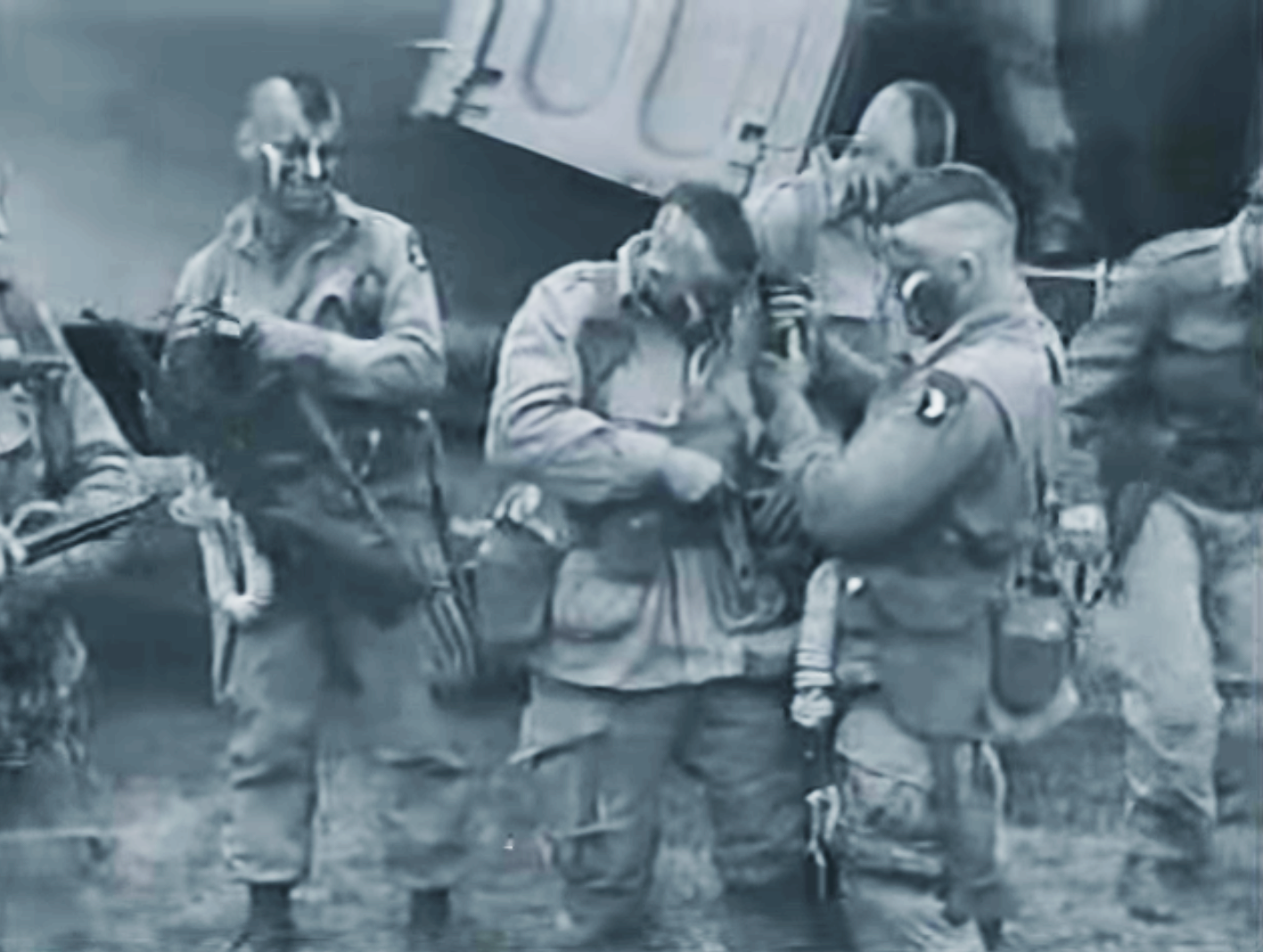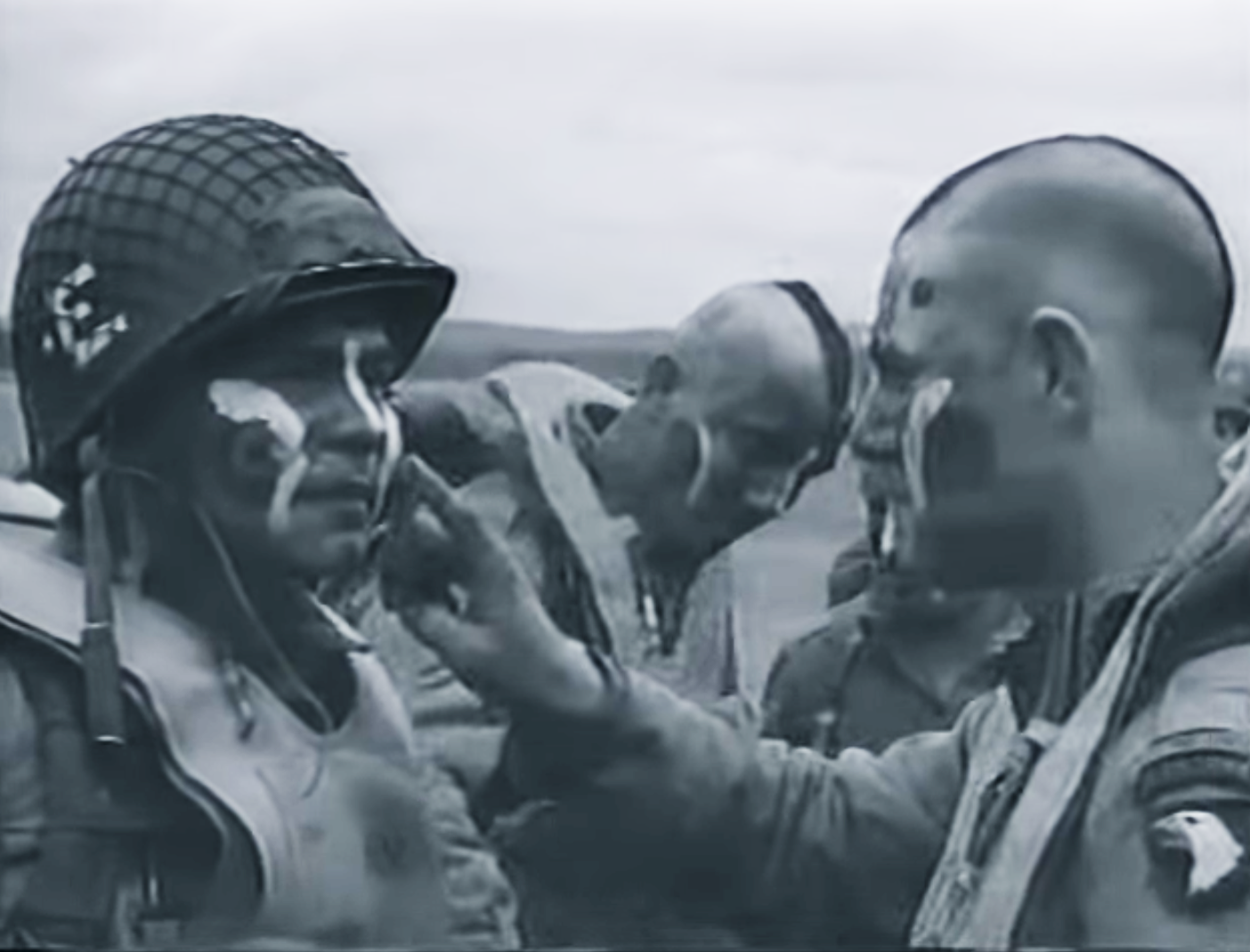Caveat Lector! I had more fun with this series of posts than a novice blogger ought to have, which means you’ll probably find the next five posts somewhat self-indulgent.
The Painting
I recently came across this fabulous painting of the Filthy Thirteen by Joel Iskowitz. It depicts the 1st Demolition Unit of the 506 Parachute Infantry Regiment of the vaunted 101st Airborne Division (that of Band of Brothers fame) as they prepared to board a C-47 Skytrain in an airfield in England on June 6, 1944. It is based on a photo published in the Stars and Stripes on June 9, 1944 — just days after D-Day. Iskowitz’s painting is reproduced here for discussion purposes under the fair use exception to the copyright laws.  I was smitten. This is a classic example of an artist brilliantly blending art and history to create something more beautiful than either: the historical importance of the scene; the seemingly relaxed poses of the men clearly fraught with tension; the introspected expressions on their faces, which actually look like those of the real subjects; the attention to accuracy in detail, such as the weapons and equipment; the workhorse C-47 Skytrain with its alternating white-black-white invasion stripes in the background, with all the power it evokes; and the absolutely stunning sky, which despite its beauty portends the furious storm that was D-Day.
I was smitten. This is a classic example of an artist brilliantly blending art and history to create something more beautiful than either: the historical importance of the scene; the seemingly relaxed poses of the men clearly fraught with tension; the introspected expressions on their faces, which actually look like those of the real subjects; the attention to accuracy in detail, such as the weapons and equipment; the workhorse C-47 Skytrain with its alternating white-black-white invasion stripes in the background, with all the power it evokes; and the absolutely stunning sky, which despite its beauty portends the furious storm that was D-Day.
The Unit
The Filthy Thirteen — actually, it was more like “the 20 unbathed misfits” — was an elite demolition unit created and trained to undertake difficult, suicidal missions, often behind enemy lines. They were led by then-25-year-old Jake McNiece, a sergeant from Oklahoma who was half-Choctaw. They became famous after the aforementioned Stars and Stripes article was published in 1944. While the article’s overall premise was mostly accurate, it resulted in a number of myths that became the basis for the 1965 novel The Dirty Dozen, which, in turn, was the basis for the 1967 film of the same name, a blockbuster of a movie that spawned several sequels and a TV series.
Yes, the Filthy Thirteen really existed, though their story has been extensively fictionalized by a movie that bears only a passing resemblance to the real unit. No, they weren’t convicts, though some often flirted with trouble. Yes, they were filthy, bathing only once a week. No, they weren’t Native American, though they did sport Mohawk haircuts and Indian war paint in honor of their half-Choctaw leader. And yes, above all, they were misfits — the type who deliberately disobey rules they find useless, like saluting officers, yet somehow manage to get the job done. (In taped interviews, McNiece actually refers to saluting officers as “malarkey” and standing retreat as “stupid.”)
This first — professional quality — photo is the one that appeared in the 1944 Stars and Stripes article. The Jumps
The Jumps
The Filthy Thirteen participated in three of the best known episodes of the war in the European Theatre — the Normandy Invasion in France, Operation Market Garden in Holland, and the Battle of the Bulge in Belgium. During the Normandy Invasion in June 1944, the Filthy Thirteen parachuted behind enemy lines, destroying two bridges and securing a third on the Douve River, which marked the boundary between Utah Beach and Omaha Beach, to prevent the Germans from reinforcing the beach heads. Of those who jumped, more than half perished during the mission.
The group made their second jump in September 1944, during Operation Market Garden, in Eindhoven, Holland. Market Garden was dependent on Highway 69 as its only route of advance and supply and the Filthy Thirteen were tasked with holding bridges to ensure that this vital corridor, which came to be known as “Hell’s Highway” because of the carnage it witnessed, remained open. This they did — for well over two months. (That does it: it’s time to endure A Bridge Too Far, for the umpteenth time. 🙂 )
Following those two missions, the Filthy Thirteen disbanded and the handful who survived — I believe it was six — joined the 101st Airborne Division Pathfinder Company – an elite group of specially trained paratroopers assigned to jump into enemy territory ahead of the main force to mark landing and drop zones to guide the main force. With the 101st Airborne encircled in Bastogne in December 1944 during the Battle of the Bulge, resupply became critical. Because of the heavy cloud cover, the Pathfinders were ordered to parachute in to set up electronic beacons for C-47 aircraft to follow when dropping their sorely-needed supplies. The Pathfinders completed their mission successfully and the 101st Airborne was effectively resupplied. I captured the photo above from a widely available video clip of the 101st on June 6, 1944, just before the Filthy Thirteen took off from England. Forgive the bad quality.
I captured the photo above from a widely available video clip of the 101st on June 6, 1944, just before the Filthy Thirteen took off from England. Forgive the bad quality.
This last lagniappe photo, also captured from the aforementioned video clip, shows Jack McNiece putting warpaint on someone who, to my eyes, appears to be Mike Marquez, a Texas native who was the only Hispanic member of the team, though some have identified him as Johnny Hale. Together, all three photos form the basis of Iskowitz’s painting and you can identify all three vignettes in various parts of the scene. The Books
The Books
In addition to The Dirty Dozen (1965) novel by E.M. Nathanson, at least three nonfiction books have been published about this colorful unit: The Filthy Thirteen (2003) by Richard E. Killblane; Fighting With The Filthy Thirteen: The World War II Story of Jack Womer – Ranger and Paratrooper (2012) by Stephen DeVito; and War Paint: The Filthy Thirteen Jump Into Normandy (2013) also by Richard E. Killblane. For a detailed history of the unit, the reader is directed to these books as this synopsis was intended merely as a predicate for Part 2.
I hope you enjoyed this simple post. For those who, like me, love figure conversions, stay tuned next week for Part 2: Creating the Unit in 1/72 Scale. As always, comments, questions, corrections, and observations are welcome.

Chris Pflueger says:
I hadn’t seen your Filthy Thirteen series before — well done! The detailed attention to the subject and the writing that brings it to us are exemplary.
Chris (Schopenhauer’s Workshop)
P.S. I’ve been on a bit of a paratroop binge myself lately, with a glider, a transport, both British and American figures, ground vehicles, and even a whole airfield… Spurred, I think, by re-watching A Bridge Too Far this past summer!
chules says:
Thanks Chris. Your comment means a lot to me and helped encourage me to complete this Filthy Thirteen series of posts. I’m actually on a Fallschirmjager kick myself, having recently obtained the Corgi Crete Ju52 Transporter and numerous Fallschirmjager figures. I hope to do a post on the figures in the future.
I’ve seen A Bridge Too Far several times and find that my enjoyment does not diminish with time.
Best regards,
chules